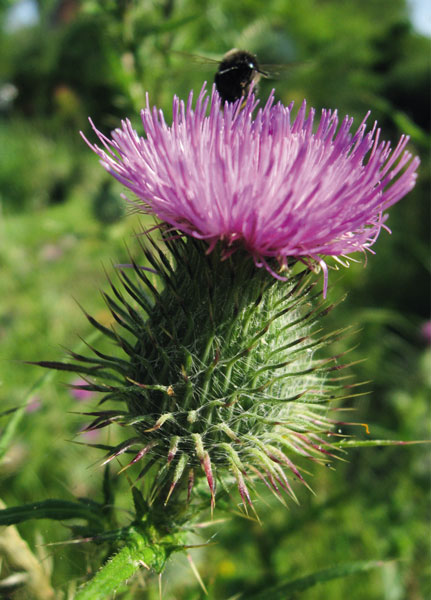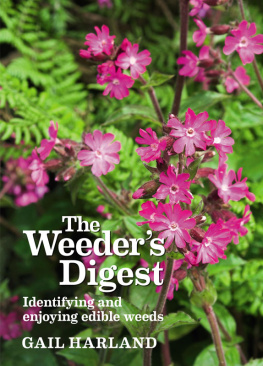Harland - The Weeders Digest
Here you can read online Harland - The Weeders Digest full text of the book (entire story) in english for free. Download pdf and epub, get meaning, cover and reviews about this ebook. publisher: UIT Cambridge Ltd., genre: Children. Description of the work, (preface) as well as reviews are available. Best literature library LitArk.com created for fans of good reading and offers a wide selection of genres:
Romance novel
Science fiction
Adventure
Detective
Science
History
Home and family
Prose
Art
Politics
Computer
Non-fiction
Religion
Business
Children
Humor
Choose a favorite category and find really read worthwhile books. Enjoy immersion in the world of imagination, feel the emotions of the characters or learn something new for yourself, make an fascinating discovery.
The Weeders Digest: summary, description and annotation
We offer to read an annotation, description, summary or preface (depends on what the author of the book "The Weeders Digest" wrote himself). If you haven't found the necessary information about the book — write in the comments, we will try to find it.
The Weeders Digest — read online for free the complete book (whole text) full work
Below is the text of the book, divided by pages. System saving the place of the last page read, allows you to conveniently read the book "The Weeders Digest" online for free, without having to search again every time where you left off. Put a bookmark, and you can go to the page where you finished reading at any time.
Font size:
Interval:
Bookmark:



First published in 2012 by
Green Books
Dartington Space, Dartington Hall,
Totnes, Devon TQ9 6EN
2012 Gail Harland
All rights reserved
No part of this book may be used or reproduced in any manner without written permission, except in the case of brief quotations in critical articles or reviews.
Design by Jayne Jones
All photographs are by the author except the following:
page 48: right: Debs Cook; page 49: bottom left: Dave Hamilton,
bottom right: iStock; page 50: left: Gary K Smith / Alamy, right: Dave Hamilton;
pages 66 and 137: FloralImages / Alamy; page 142: iStock
Print edition ISBN 978 1 900322 99 7
PDF format ISBN 978 0 85784 104 9
ePub format ISBN 978 0 85784 105 6
Cover image: red campion
Back cover images: left: oxeye daisy; centre: Japanese
knotweed; right: greater stitchwort
Page 2 image: spear thistle
Disclaimer:
Many of the foods we eat can be toxic to some degree, and particular individuals can be allergic to almost anything. At the time of going to press, the advice and information in this book are believed to be true and accurate. However, it is sensible to be cautious when trying new plants to eat: make quite sure that you have identified them correctly and try them in moderation to begin with. The author and publishers accept no liability for actions inspired by this book.
Acknowledgements
I would like to thank ecologist Sue Wilson for help with identification; Chris and Jenny Seagon at Laurel Farm Herbs in Kelsale, Suffolk; Janet Bayliss and the librarians at the Ipswich Hospital medical library; and everyone at Green Books, but especially Amanda Cuthbert. Special thanks to Ashley and Jonathan for allowing occasional access to the computer, helping with computer problems, putting up with me stopping the car in random places to photograph weeds, and, of course, for tasting all the recipes.
To Ashley and Jonathan, who have come to view my trips into the garden with a colander with grave suspicion, but nevertheless stoically eat the resulting offerings.
Introduction
What is a weed? A plant whose virtues have not been discovered. So said Ralph Waldo Emerson in his Fortune of the Republic lecture of 1878 and today there are still many common plants whose virtues are not widely recognised. Wild plants are often dismissed as weeds and ruthlessly eliminated from the garden even though they may have qualities as valuable as those plants that are cultivated in their place. The large white trumpets of the familiar hedge bindweed are as beautiful as those of morning glories, and in cold northern gardens it is much easier to grow. However, while bindweed is sometimes encouraged to scramble up and cover an ugly chain-link fence, its tendency to go on the rampage means that it is understandably rarely tolerated in the well-ordered garden.

Hedge bindweed is handsome but rampant.
There is no standard botanical definition of a weed. Typing botanical definition of weed into a popular internet search engine produces over a million results, but the majority of these seem to refer to the cannabis plant. The Compact Oxford English Dictionary definition as a wild plant growing where it is not wanted is probably the most widely accepted use of the word. Distinguishing between weeds and wildflowers can be particularly problematic. Some gardeners will dismiss as weeds those plants that will have others quoting from Shakespeares Othello, 0 thou weed, Who art so lovely fair and smellst so sweet / That the sense aches at thee. For the purposes of this book I have included as weeds several plants which may be bought as ornamentals or grown as vegetables, but which share a tendency to spread vigorously in some situations.
Calling a person a weed implies that you think he or she is puny and weak, but weeds themselves may be nothing of the sort. A mature plant of the giant hogweed will tower over most men, and Japanese knotweed quickly becomes an aggressive thug that is very difficult to control. Shakespeare did not have to worry about Japanese knotweed in the garden as it was not introduced to Britain until the 1820s. He did acknowledge the power of the weed, though, when in the play Richard III he had the Duke of York describe how he had heard his uncle say Small herbs have grace; great weeds do grow apace. Certainly the smallest root of Japanese knotweed can soon grow into a plant big enough to supply shoots for the whole family to eat.
Some weeds are avoided by people with very good reason. In North America, the very common weed poison ivy is loathed and feared by those people susceptible to its poison. The urushiol in its sap causes an allergic reaction which leads to a severe inflammation and blistering of the skin. American children soon learn the rhymes Leaves of three; let it be and Hairy vine, no friend of mine to remind them to avoid the plant. Children often have a greater familiarity with weeds than adults do, perhaps because they have fewer preconceptions and a greater inclination to look at the details of a plant. Generations of children have used the hairs from rose hips as an itching powder with which to play practical jokes on unsuspecting victims.
Weeding
The majority of weed species are natives and they tend to be those which thrive in habitats disturbed by human activity gardens, of course, being a prime example. The horsetail, whose roots go down to hell and back, and the golden sow-thistles may have been living in your garden long before anyone thought to build a house on the land. Indeed, the perennial sow-thistle is thought to be one of the first plants to recolonise the British Isles after the last ice age. The most problematic weeds in a garden, though, may well not be native, but alien species which have been introduced for their ornamental or other uses. Like the alien invaders beloved of science fiction films, these can often run rampant and prove to be very difficult to control.

Sheeps sorrel growing with black Hungarian peppers.
Gardeners often find the problem of weed control on their patch to be overwhelming, and it can certainly be very disheartening to spend time battling with weeds only to have them reappear the moment your back is turned. However, many weeds are as nutritious to us as traditional vegetables such as spinach; indeed, the common weed fat hen and other members of the family Chenopodiaceae were valued as food, long before spinach was introduced to gardens. By viewing weeds as potential sources of food rather than of irritation, the gardeners plot becomes less of a battlefield and more a place of peace and plenty.
Not everyone hates weeding, and indeed some people find it quite therapeutic. The American President John Adams (1735-1826) once wrote that his time might have been better spent doing such things as weeding Carrotts, picking or shelling Peas. When weeding, you are, of course, outdoors in the fresh air and if the bees are humming and the birds singing you can enjoy the natural environment while doing something active and useful. Concentrating on a relatively simple task can push any worries from your mind, if only temporarily. Weeding is a job that can be done while a large part of your mind is daydreaming about other things, although this sometimes has unfortunate results. Most gardeners will readily admit to having pulled up some prized garden plant in moments of abstraction while getting the weeding done.
Next pageFont size:
Interval:
Bookmark:
Similar books «The Weeders Digest»
Look at similar books to The Weeders Digest. We have selected literature similar in name and meaning in the hope of providing readers with more options to find new, interesting, not yet read works.
Discussion, reviews of the book The Weeders Digest and just readers' own opinions. Leave your comments, write what you think about the work, its meaning or the main characters. Specify what exactly you liked and what you didn't like, and why you think so.








